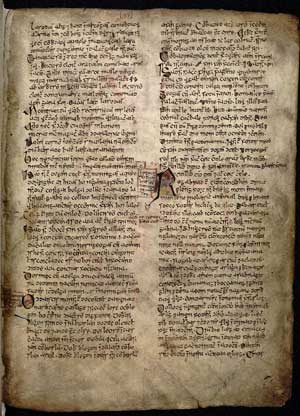Estimating the survival of texts and manuscripts in the Gaelic tradition
Published in Issue 5 (September/October 2022), News, Volume 30
Above: A page from Leabhar na hUidhre/Book of the Dun Cow, written at Clonmacnoise in 1106. No manuscripts written completely in Irish survive from before then. (RIA)
By Pádraig Ó Macháin
No manuscripts written completely in Irish survive from before 1106, when our oldest Gaelic manuscript, Leabhar na hUidhre, was written. Together with two other manuscripts, these are the only ones to survive from the twelfth century. From the thirteenth century none survive; from the fourteenth fewer than twenty; which means that the bulk of the 300 to 350 manuscripts that survive from the period before the Battle of Kinsale are products of the fifteenth and sixteenth centuries. The early seventeenth century marks the end of the production of vellum manuscripts—of which fewer than ten survive from that time—and the beginning of the proliferation of manuscripts written on paper, of which around 4,100 survive from that period to the end of the tradition in the late nineteenth century.
The wholesale loss of manuscripts of the medieval and late-medieval periods can be attributed to a number of factors, not least of which must have been the precarious storage of such books. If not held in the scholars’ schools or houses, the evidence, such as it is, suggests that books—along with other items of value—might be stored in churches, which were nominally supposed to be exempt from plunder. This was no protection against fires, however, whether accidental or caused by war. The fire that destroyed the church of Inis Mór on Loch Gill in 1416, in which the books of the Ó Cuirnín scholars were lost, is an example of accidental destruction; the burning of the churches of Clonmacnoise (1552) and Armagh (1642), together with their books, is but a token of the destruction caused by war, which was by far the greatest cause of the loss of books over the centuries.
In the seventeenth century many manuscripts were taken abroad by their owners. Only a handful ever returned; and a handful is all that survives of the books of those exiles remaining on the Continent today. Further losses occurred due to the dispersal of private collections. Only a subscription raised by the army of Oliver Cromwell saved the collection of Archbishop James Ussher from dispersal following his death in 1656. Books continued to be lost in the modern era, including medieval works such as the Book of Clonenagh and the miscellany known as the Psalter of Cashel.
Along with the loss of books came the loss of the literature that they contained. However, a curious feature of the textual history of literature in the Irish language suggests that this loss may not have been as severe as that of the manuscripts. That feature is the continuous transmission, over many centuries, of texts that were composed hundreds of years earlier. All texts of the Old-Irish and early Middle-Irish periods—up to 1100—owe their preservation to later copies; in some cases those copies survive only in paper manuscripts of the post-1600 era. While these survivals, therefore, are indicative of the great loss of the manuscripts contemporary with the date of the composition of these early texts, they also demonstrate how it was possible for texts to survive despite such losses.
Up to now, estimating the extent of the loss of manuscripts has seemed a futile exercise. Surveying the 300 to 350 books (including fragments) that survive from the period 1100 to 1600 leaves one with the impression that this must be but a fraction of what once existed, particularly as these survivals are mainly from the fifteenth and sixteenth centuries, and a third of them are medical in content. Since 2020, a team of scholars led by Prof. Mike Kestemont of the University of Antwerp has been examining the question of the loss of texts and manuscripts as evidenced by the vernacular traditions of the Netherlands, Germany, France, England, Iceland and Ireland. At the core of this codicological and textual study has been the application of an ecological species-survival model and formula known as the Chao1 Estimator developed in 1984 by the Taiwanese statistician Prof. Anne Chao. The Estimator is a formulaic application that uses information of rare species that are detected once or twice to estimate the number of undetected species. Prof. Chao also linked her work to Good-Turing frequency theory, first developed to calculate undetected code-elements by Alan Turing, the Bletchley Park cryptographer.
The manuscripts research project applied Prof. Chao’s estimator to the survival of narrative texts in the literatures of the countries represented. Irish narrative literature included native tales as well as adaptations of Classical and Arthurian literature surviving in manuscripts that were written before 1600. In general terms the results show, for Ireland, a significant survival of texts (81%) despite a survival rate of manuscripts of only 19.2%. This result confirms what the textual history of Gaelic literature has always hinted at, and it has gone further by quantifying the survival data. This is especially significant for our understanding of the amount of Irish manuscripts that once existed, and there is much that can be extrapolated from these data as the project progresses.
Pádraig Ó Macháin is Professor and Head of the Department of Modern Irish at University College Cork.
Further reading
M. Kestemont, F. Karsdorp, E. De Bruijn, M. Driscoll, K.A. Kapitan, P. Ó Macháin, D. Sawyer, R. Sleiderink, A. Chao, ‘Forgotten books: the application of unseen species models to the survival of culture’, Science 375 (6582) (2022), 765–9.
















